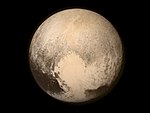astro.wikisort.org - Asteroid
2015 YU9, also known as 2015 YB[lower-alpha 1] and WY032FF, is a sub-kilometer Hungaria asteroid from the inner region of the asteroid belt, approximately 350 meters in diameter. It was first observed on 16 December 2015, by the Catalina Sky Survey at Mount Lemmon Observatory in Arizona, United States.[2]
| Discovery[1][2] | |
|---|---|
| Discovered by | CSS |
| Discovery site | Mount Lemmon Obs. |
| Discovery date | 16 December 2015 |
| Designations | |
MPC designation | 2015 YU9 |
Alternative designations | 2015 YB (deleted)[1][2][lower-alpha 1] WY032FF |
Minor planet category | main-belt (inner)[1] · Hungaria[3] |
| Orbital characteristics[1][4] | |
| Epoch 4 September 2017 (JD 2458000.5) | |
| Uncertainty parameter 5 | |
| Observation arc | (32 days) |
| Aphelion | 2.0210 AU |
| Perihelion | 1.7786 AU |
Semi-major axis | 1.8998 AU |
| Eccentricity | 0.0638 |
Orbital period (sidereal) | 2.62 yr (956 days) |
Mean anomaly | 231.75° |
Mean motion | 0° 22m 35.04s / day |
| Inclination | 20.031° |
Longitude of ascending node | 236.54° |
Argument of perihelion | 208.74° |
| Physical characteristics | |
| Dimensions | 0.35 km (est. at 0.3)[5] |
Absolute magnitude (H) | 19.228[1] |
Description
Orbit
2015 YU9 is a member of the dynamical Hungaria group, which form the innermost dense concentration of bright asteroids in the Solar System.[3] It orbits the Sun at a distance of 1.8–2.0 AU once every 2 years and 7 months (956 days). Its orbit has an eccentricity of 0.06 and an inclination of 20° with respect to the ecliptic.[1]
Discovery
Precovery images were taken by Pan-STARRS on 8 December 2015.[2][3] At the time of discovery the asteroid was 0.8 AU (120,000,000 km; 74,000,000 mi) from Earth which is close to the Earth minimum orbit intersection distance (MOID).[4] The asteroid came to perihelion (closest approach to the Sun) around 28 December 2015.[4]
When the asteroid was first detected and it had an observation arc less than 1 day, the asteroid was suspected of being a Near-Earth asteroid that would make a close approach to Earth on 19 December 2015.[lower-alpha 1] But that orbit solution used an erroneous observation from the Catalina Sky Survey causing an incorrect orbit determination.[3] The asteroid is not a near-Earth object.
Diameter and albedo
With an absolute magnitude of 19.2, the inner main-belt asteroid is approximately 350 meters in diameter, based on an assumed albedo of 0.3 – a typical compromise value between 0.4 and 0.2, corresponding to the Hungaria asteroids both as family and orbital group.[5]
Inncorrect media reports
Initial mass media reports for the size of the asteroid were incorrectly based on the assumption the asteroid was 0.02 AU from Earth and not 0.8 AU from Earth.[citation needed] On 31 December 2015 the asteroid received the provisional designation 2015 YU9.
Notes
- Archived JPL Small Body Data Base, of JPL solution #1 for asteroid 2015 YB on 17 December 2015 with an observation arc of less than a 1 day. This database entry has been deleted since.
References
- "JPL Small-Body Database Browser: (2015 YU9)" (2016-01-09 last obs.). Jet Propulsion Laboratory. Retrieved 2 August 2017.
- "2015 YU9". Minor Planet Center. Retrieved 2 August 2017.
- "MPEC 2015-Y31 : RETRACTION OF 2015 YB". IAU Minor Planet Center. 19 December 2015. Retrieved 9 September 2020. (retraction)
- Gray, Bill. "Pseudo-MPEC for WY032FF". Project Pluto. Archived from the original on 19 December 2015. Retrieved 29 December 2015. (NEOCP)
- "Asteroid Size Estimator". CNEOS/JPL. Retrieved 1 August 2017.
External links
- 2015 YU9 at AstDyS-2, Asteroids—Dynamic Site
- 2015 YU9 at ESA–space situational awareness
- 2015 YU9 at the JPL Small-Body Database
Другой контент может иметь иную лицензию. Перед использованием материалов сайта WikiSort.org внимательно изучите правила лицензирования конкретных элементов наполнения сайта.
WikiSort.org - проект по пересортировке и дополнению контента Википедии


